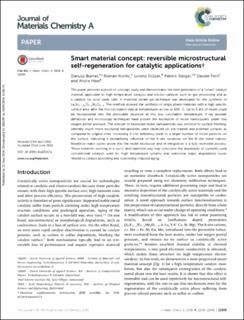Please use this identifier to cite or link to this item:
https://doi.org/10.21256/zhaw-1563Full metadata record
| DC Field | Value | Language |
|---|---|---|
| dc.contributor.author | Burnat, Dariusz Artur | - |
| dc.contributor.author | Kontic, Roman | - |
| dc.contributor.author | Holzer, Lorenz | - |
| dc.contributor.author | Steiger, Patrick | - |
| dc.contributor.author | Ferri, Davide | - |
| dc.contributor.author | Heel, Andre | - |
| dc.date.accessioned | 2018-01-18T10:45:47Z | - |
| dc.date.available | 2018-01-18T10:45:47Z | - |
| dc.date.issued | 2016 | - |
| dc.identifier.issn | 2050-7488 | de_CH |
| dc.identifier.uri | https://digitalcollection.zhaw.ch/handle/11475/2116 | - |
| dc.description.abstract | This paper presents a proof-of-concept study and demonstrates the next generation of a “smart” catalyst material, applicable to high temperature catalysis and electro-catalysis such as gas processing and as a catalyst for solid oxide cells. A modified citrate-gel technique was developed for the synthesis of LaxSr1−1.5xTi1−yNiyO3−δ. This method allowed the synthesis of single phase materials with a high specific surface area, after the first calcination step at temperatures as low as 650°C. Up to 5 at% of nickel could be incorporated into the perovskite structure at this low calcination temperature. X-ray powder diffraction and microscopy techniques have proven the exsolution of nickel nanoclusters under low oxygen partial pressure. The amount of exsoluted nickel nanoparticles was sensitive to surface finishing, whereby much more exsoluted nanoparticles were observed on pre-treated and polished surfaces as compared to original ones. Increasing A-site deficiency leads to a larger number of nickel particles on the surface, indicating a destabilizing influence of the A-site vacancies on the B-site metal cations. Repetitive redox cycles prove that the nickel exsolution and re-integration is a fully reversible process. These materials working in a cyclic and repetitive way may overcome the drawbacks of currently used conventional catalysts used for high temperature systems and overcome major degradation issues related to catalyst poisoning and coarsening-induced aging. | de_CH |
| dc.language.iso | en | de_CH |
| dc.publisher | Royal Society of Chemistry | de_CH |
| dc.relation.ispartof | Journal of Materials Chemistry A | de_CH |
| dc.rights | Licence according to publishing contract | de_CH |
| dc.subject | Map | de_CH |
| dc.subject | Self-regeneration | de_CH |
| dc.subject | Smart Materials | de_CH |
| dc.subject | SOFC | de_CH |
| dc.subject.ddc | 540: Chemie | de_CH |
| dc.subject.ddc | 620.11: Werkstoffe | de_CH |
| dc.title | Smart material concept : reversible microstructural self-regeneration for catalytic applications | de_CH |
| dc.type | Beitrag in wissenschaftlicher Zeitschrift | de_CH |
| dcterms.type | Text | de_CH |
| zhaw.departement | School of Engineering | de_CH |
| zhaw.organisationalunit | Institute of Computational Physics (ICP) | de_CH |
| zhaw.organisationalunit | Institute of Materials and Process Engineering (IMPE) | de_CH |
| dc.identifier.doi | 10.21256/zhaw-1563 | - |
| dc.identifier.doi | 10.1039/C6TA03417A | de_CH |
| zhaw.funding.eu | No | de_CH |
| zhaw.issue | 30 | de_CH |
| zhaw.originated.zhaw | Yes | de_CH |
| zhaw.pages.end | 11948 | de_CH |
| zhaw.pages.start | 11939 | de_CH |
| zhaw.publication.status | publishedVersion | de_CH |
| zhaw.volume | 4 | de_CH |
| zhaw.publication.review | Peer review (Publikation) | de_CH |
| Appears in collections: | Publikationen School of Engineering | |
Files in This Item:
| File | Description | Size | Format | |
|---|---|---|---|---|
| 2016_Burnat_Smart material concept_Journal of Materials Chemistry A.pdf | 1.45 MB | Adobe PDF |  View/Open |
Show simple item record
Burnat, D. A., Kontic, R., Holzer, L., Steiger, P., Ferri, D., & Heel, A. (2016). Smart material concept : reversible microstructural self-regeneration for catalytic applications. Journal of Materials Chemistry A, 4(30), 11939–11948. https://doi.org/10.21256/zhaw-1563
Burnat, D.A. et al. (2016) ‘Smart material concept : reversible microstructural self-regeneration for catalytic applications’, Journal of Materials Chemistry A, 4(30), pp. 11939–11948. Available at: https://doi.org/10.21256/zhaw-1563.
D. A. Burnat, R. Kontic, L. Holzer, P. Steiger, D. Ferri, and A. Heel, “Smart material concept : reversible microstructural self-regeneration for catalytic applications,” Journal of Materials Chemistry A, vol. 4, no. 30, pp. 11939–11948, 2016, doi: 10.21256/zhaw-1563.
BURNAT, Dariusz Artur, Roman KONTIC, Lorenz HOLZER, Patrick STEIGER, Davide FERRI und Andre HEEL, 2016. Smart material concept : reversible microstructural self-regeneration for catalytic applications. Journal of Materials Chemistry A. 2016. Bd. 4, Nr. 30, S. 11939–11948. DOI 10.21256/zhaw-1563
Burnat, Dariusz Artur, Roman Kontic, Lorenz Holzer, Patrick Steiger, Davide Ferri, and Andre Heel. 2016. “Smart Material Concept : Reversible Microstructural Self-Regeneration for Catalytic Applications.” Journal of Materials Chemistry A 4 (30): 11939–48. https://doi.org/10.21256/zhaw-1563.
Burnat, Dariusz Artur, et al. “Smart Material Concept : Reversible Microstructural Self-Regeneration for Catalytic Applications.” Journal of Materials Chemistry A, vol. 4, no. 30, 2016, pp. 11939–48, https://doi.org/10.21256/zhaw-1563.
Items in DSpace are protected by copyright, with all rights reserved, unless otherwise indicated.